|
|
|
Sort Order |
|
|
|
Items / Page
|
|
|
|
|
|
|
| Srl | Item |
| 1 |
ID:
164553
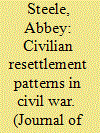

|
|
|
|
|
| Summary/Abstract |
This article proposes a descriptive typology of civilian resettlement patterns in civil wars. The patterns vary in two dimensions: whether or not displaced civilians cluster together or resettle independently, and if they remain within their home country or not. The combination of the factors leads to four resettlement patterns: expulsion, segregation, integration, and dispersion. Expulsion and segregation occur when the displaced cluster, either within the home state (segregation) or beyond it (expulsion). Integration and dispersion occur when the displaced do not cluster but seek to blend in with other communities, either abroad (dispersion) or within core cities and towns in the state (integration). After introducing the typology and illustrating it with examples, the article engages in theory-building to explain variation in resettlement patterns. It argues that resettlement forms are based on the type of displacement that civilians experience, and the perpetrator of the violence. The displacement type influences individuals’ best strategy for achieving relative safety. Within and across wars, groups that experience political cleansing are likely to cluster together for safety. The best destination options for the displaced to resettle depend on the perpetrator, which lead to clustering either within a state if the actor is non-state, or outside the state if the actor is the state or an ally. The argument is illustrated with examples. Finally, the article considers the implications of resettlement patterns for violence, conflict, and state-building.
|
|
|
|
|
|
|
|
|
|
|
|
|
|
|
|
| 2 |
ID:
155494
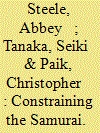

|
|
|
|
|
| Summary/Abstract |
On the eve of the Meiji Restoration in 1868, the nearly 300 semi-autonomous domains across Japan had widely varying tax rates. Some handed over 70 percent of their rice yield to the samurai ruler of the domain, while others provided 15 percent. This variation existed in spite of the similar fiscal demands that the domain rulers faced within the Tokugawa regime—the feudal system that governed Japan between 1603 and 1868. This period was remarkably stable; Japan saw no foreign or domestic wars. This allows us to focus on the impact of pressure from below on taxation. We study the extent to which peasant-led rebellions and collective desertion (“flight”) lowered the subsequent tax rate imposed by samurai rulers. Using newly compiled data on different types of peasant-led political mobilization—from petitions to insurrections—we find an association between, on the one hand, large-scale rebellions and flight and, on the other, lower tax rates. We interpret the results as evidence of rebellious or mobile peasants’ ability to constrain their rulers; the more complacent fail to win concessions. Our findings suggest that peasant mobilization played a role in restricting state growth in early modern Japan through tax concessions.
|
|
|
|
|
|
|
|
|
|
|
|
|
|
|
|
| 3 |
ID:
105913
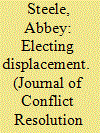

|
|
|
|
|
| Publication |
2011.
|
| Summary/Abstract |
This article highlights a nefarious effect of elections during civil wars by demonstrating that they can facilitate the displacement of civilians. In contrast to the perception of displacement as haphazard, the author argues that armed groups displace strategically when they attempt to gain control over a territory, and where they have information about civilians' loyalties. Although inferring preferences is difficult in the context of civil wars, elections conducted before or during a violent conflict are one way that armed groups can identify local cleavages and ''disloyal'' residents. The author tests implications of the argument with original, microlevel quantitative and qualitative data from northwest Colombia. Using voter files and disaggregated electoral returns, the author shows that residents in urban neighborhoods that supported the insurgent-backed political party, the Patriotic Union (UP), were more likely to leave the city of Apartadó than were neighbors in other districts. However, residents of the nearby rural communities that supported the UP were the least likely to leave. The author traces the patterns of violence across the communities using local archival materials and interviews to assess how well the argument accounts for the variation observed, and to explore the unexpected outcome in the rural area. While the author finds that counterinsurgents attempted strategic displacement in both the city and the mountains, they only succeeded in the urban areas because residents of the rural hamlets were uniquely able to overcome the collective action problem that strategic displacement generates. The findings demonstrate that political identities are relevant for patterns of violence, and that cleansing occurs even in nonethnic civil wars.
|
|
|
|
|
|
|
|
|
|
|
|
|
|
|
|
| 4 |
ID:
162459
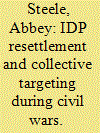

|
|
|
|
|
| Summary/Abstract |
Refugees and internally displaced people (IDPs) are not always safe where they resettle in ethnic civil wars, in which civilians’ identities overlap with the ethnic profile of armed combatants. This article argues that IDPs are also vulnerable in non-ethnic civil wars, through two related mechanisms that indicate civilians’ loyalties: (1) where the displaced are from and when they left; and (2) resettlement patterns. The first can suggest loyalties when the displacement is associated with territorial conquest and expulsion of suspected sympathizers. In turn, the displaced would be considered disloyal by the armed group responsible for the expulsion, and could be subject to further violence where they resettle. The second mechanism relates to the first: if displaced civilians are considered disloyal, then resettling with other, similarly stigmatized civilians can improve their security by reducing the household’s risk of discovery. However, clustering together with other IDPs can have a perverse effect: even though living in an enclave may reduce a particular household’s likelihood of suffering violence, the group itself is endangered because it is more easily detected. Armed groups can collectively target IDPs who resettle in clusters, either for strategic or retributive reasons. Implications of the argument are tested with detailed subnational panel data on IDP arrivals and massacres in Colombia, and the analyses provide support for the argument. The findings indicate that collective targeting of IDPs occurs even in civil wars without an ethnic cleavage, following voluntary resettlement patterns, and reinforces IDP security as a policy priority.
|
|
|
|
|
|
|
|
|
|
|
|
|
|
|
|
| 5 |
ID:
088358
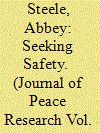

|
|
|
|
|
| Publication |
2009.
|
| Summary/Abstract |
Despite civil war violence, some civilians stay in their communities. Those who leave choose one of many possible destinations. Drawing on fieldwork in Colombia, this article argues that the way armed groups target civilians explains households' decisions about displacement. When groups of civilians are targeted based on a shared characteristic - `collective' targeting - their best options for avoiding violence differ from those targeted selectively or indiscriminately. This article outlines conditions under which people can stay in contexts of collective targeting, and where they are likely to go if these conditions are not met. A civilian facing collective targeting could move to a rival group's stronghold, cluster with others similarly targeted, or seek anonymity in a city or different region. Community characteristics, such as whether it is urban or rural, as well as macro characteristics of the war, such as whether or not there is an ascriptive cleavage, shape which decisions are relatively safest, which in turn leads to implications for aggregate patterns. For example, clustering together has a perverse effect: even though hiding among others with similar characteristics may reduce an individual's likelihood of suffering direct violence, the community may be more endangered as it is perceived to be affiliated with an armed group. This then leads to a cycle of collective targeting and displacement, which has important implications for the development of warfare. In turn, this cycle and related cleavage formation may have long-term impacts on postwar stability and politics.
|
|
|
|
|
|
|
|
|
|
|
|
|
|
|
|
| 6 |
ID:
153620


|
|
|
|
|
| Summary/Abstract |
Contemporary development assistance often takes the form of subcontracted state-building. Foreign donors hire for-profit firms to provide services and to improve or create institutions in developing countries, particularly those experiencing internal conflict. This arrangement creates two counterproductive dynamics: first, it introduces agency problems between donors, recipient states, subcontractors, and citizens; and second, it undermines the long-run development of domestic bureaucratic capacity by creating disincentives for the host government to invest. These dynamics hinder, rather than foster, the legitimacy of state institutions. This paper summarizes trends in external support to state-building since the 1970s and illustrates subcontracted state-building with examples from Colombia.
|
|
|
|
|
|
|
|
|
|
|
|
|
|
|
|
| 7 |
ID:
141181
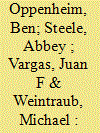

|
|
|
|
|
| Summary/Abstract |
Anti-insurgent militias and states attempt to erode insurgent groups’ capacities and co-opt insurgent fighters by promising and providing benefits. They do so to create a perception that the insurgency is unraveling and to harness inside information to prosecute more effective counterinsurgency campaigns. Why do some insurgents defect to a paramilitary group and others exit the war by demobilizing, while still others remain loyal to their group? This article presents the first empirical analysis of these questions, connecting insurgents’ motivations for joining, wartime experiences, and organizational behavior with decisions to defect. A survey of ex-combatants in Colombia shows that individuals who joined for ideological reasons are less likely to defect overall but more likely to side-switch or demobilize when their group deviates from its ideological precepts. Among fighters who joined for economic reasons, political indoctrination works to decrease their chances of demobilization and defection to paramilitaries, while opportunities for looting decrease economically motivated combatants’ odds of defection.
|
|
|
|
|
|
|
|
|
|
|
|
|
|
|
|
|
|
|
|
|